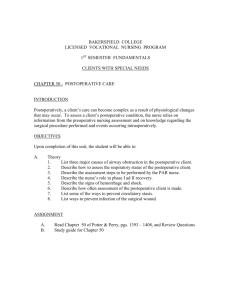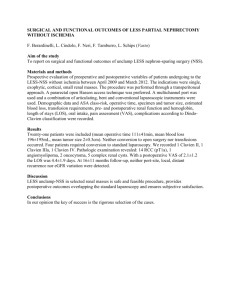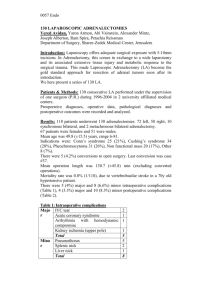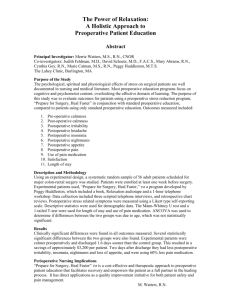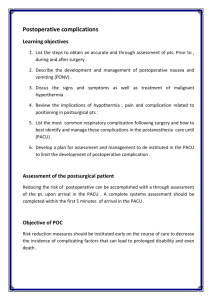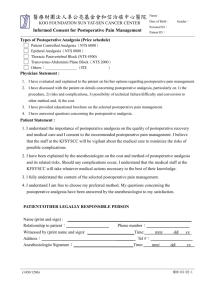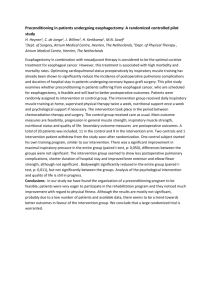Running head: EFFECTS OF MUSIC THERAPY ON PAIN
advertisement
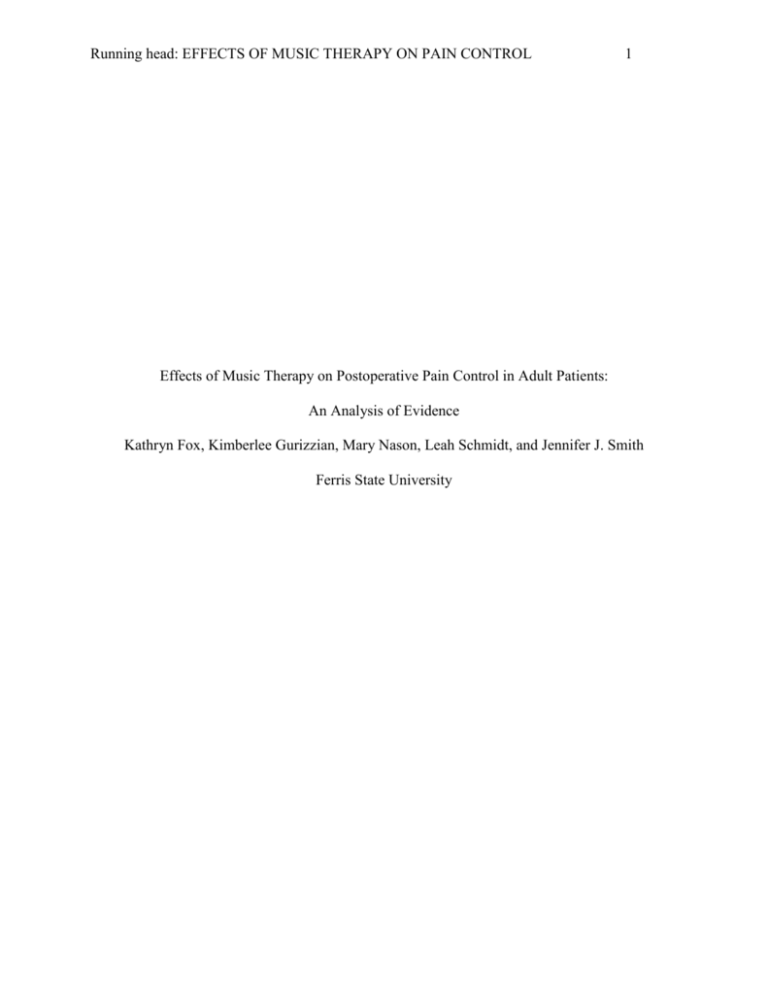
Running head: EFFECTS OF MUSIC THERAPY ON PAIN CONTROL 1 Effects of Music Therapy on Postoperative Pain Control in Adult Patients: An Analysis of Evidence Kathryn Fox, Kimberlee Gurizzian, Mary Nason, Leah Schmidt, and Jennifer J. Smith Ferris State University EFFECTS OF MUSIC THERAPY ON PAIN CONTROL 2 Abstract The purpose of this review is to identify what the nursing literature reveals about music therapy and its effects on postoperative pain control for adults. This article provides an analysis of four research articles, three are systematic reviews, and one is a randomized controlled trial. Measurements of pain include pain rating scales, opioid consumption, and physiologic measures (such as vital signs). Analysis of the evidence provided in these articles reveals that music is a cost efficient nursing intervention effective for reducing postoperative pain and promoting a calm and relaxing environment. No patients reported any increased discomfort or adverse effects from music as an intervention making it a low risk intervention. This review provides evidence to support the efficacy of music as a tool to reduce postoperative pain. Continued research is needed to support and advocate for the efficacy of music therapy as a nursing intervention to decrease patient distress in the perioperative period. EFFECTS OF MUSIC THERAPY ON PAIN CONTROL 3 Effects of Music Therapy on Postoperative Pain Control in Adult Patients Pain is a sensory process felt in the body influenced by the psychological and emotional processes of each individual. Postoperative pain is common after surgery and despite increased knowledge regarding pain management; many patients still suffer from inadequate pain control postoperatively (Engwall & Sörensen Duppils, 2009). Nurses are in a unique position to apply noninvasive methods such as music therapy in the clinical setting to decrease patients’ distress and create a calming environment. Music is a fundamental aspect of the human experience and is strongly linked to our emotions. It is a source of pleasure and is thought to elicit physiological and psychological responses in many people. Nurses have a key role in the reduction of pain and can provide optimal pain relief for patients with the use of adjunctive therapies. Music therapy, as a tool, can assist in creating a calm environment by providing distraction and promoting relaxation for optimizing emotional and spiritual well-being. The main goal of this review is to focus on the potential of musical therapy in the postoperative setting and to evaluate the efficacy of music to reduce pain intensity or analgesic requirements. The research question of “what does the nursing literature reveal about music therapy and its effects on post-operative pain control for adults?” guided this review. Method A search for scientific articles evaluating the effects of music on postoperative pain was conducted using online databases. Inclusion criteria were articles published in English, adult populations, level I or II evidence, primarily nursing research, in peer reviewed journals, and those utilizing music as their primary intervention. Table 1 (see Appendix) shows the evaluation matrix used for article inclusion. Exclusion criteria included studies that did not use music as the EFFECTS OF MUSIC THERAPY ON PAIN CONTROL 4 primary intervention, studies that were not primarily nursing research and studies that used sounds instead of music. Ten articles were found and four ultimately selected for this review (see Appendix). Three articles are systematic reviews and one is a randomized controlled trial (RCT). Three of the chosen articles were written in the United States of America and one in Sweden with all being published between 2004 and 2012. Analysis of Evidence Types of Music In Engwall and Sörensen Duppils (2009) systematic review, the aim was to examine the effect of music on postoperative pain. The studies included in this review had various methods of music choice; the researchers chose the music in nine studies, participants chose from offered selections in four studies, and in one study, participants provided their own music. The rest of the participants had a choice to bring music, choose from a selection, or listen to live harp music (selected by the musician). When the music was chosen or offered by the researchers, soft, easy listening, or classical music was offered (Engwall & Sörensen Duppils, 2009). In Dunn’s literature review (2004), the majority of the studies provided the patient with a selection of music to choose from preoperatively and two of the studies utilized music brought from home. Allowing the patient to choose music from a selection motivated the patient to be involved in their plan of care and afforded the positive effect of listening to a preferred music genre (Dunn, 2004). Nilsson’s (2008) systematic review included 15 RCTs that were performed postoperatively to determine the effect of music therapy on postoperative pain control for adults. Chosen music was soothing and self-selected in the majority of studies (Nilsson, 2008). EFFECTS OF MUSIC THERAPY ON PAIN CONTROL 5 Allred, Byers, and Sole’s (2010) study of 56 postoperative patients provided several easy listening compact discs to the experimental group. The characteristics of the music included melodic like rhythms with no lyrics, calming and soothing tones, and 60-80 beats per minute. Through review of other studies, Allred, Byers, and Sole (2010) found that music with these qualities promoted an increased sense of well-being, decreased anxiety, and increased comfort and relaxation. Types of Interventions Some of the articles reviewed by Engwall and Sörensen Duppils (2009) explained to the subjects prior to surgery what the purpose and effect of music in relation to pain was followed by a coaching session on how to use the music postoperatively to distract or relax them. One study provided patients with tapes to listen to at home twice daily before surgery in preparation for the trial (Engwall & Sörensen Duppils, 2009). Environmental manipulation was used in many studies in addition to music therapy. Noise reduction, low lighting, and stimuli reduction were often employed in the selected studies (Engwall & Sörensen Duppils, 2009). In Engwall and Sörensen Duppils (2009) review, the treatment time in most studies ranged from immediately upon arrival to the recovery room to three days postoperatively. In Nilsson’s (2008) review, headphones were utilized in the majority of the studies. The duration of postoperative listening time lasted from five minutes to four hours with the majority varying from 15-30 minutes per session. Similarly, Dunn’s (2004) review of selected studies, the time of the intervention also varied, four were initiated in the post anesthesia care unit (PACU) and continued until discharge and four were begun the day after surgery and continued until discharge from the hospital (Dunn, 2004). EFFECTS OF MUSIC THERAPY ON PAIN CONTROL 6 In Allred, Byers, and Sole’s (2010) experiment, listening time was 20 minutes before and after the first ambulation, while the control group had a rest period without music. Patients were educated prior to surgery on the purpose of the study and proper use the pain scale (Allred, Byers, & Sole, 2010). Subjects were also encouraged to choose their music selection preoperatively. Outcome Measurements In the chosen studies by Engwall and Sörensen Duppils (2009), pain was assessed before, during, and after interventions with a treatment time starting in surgery and ranging to discharge from the hospital. Apart from pain, other outcome measures were: sleep, mastery of the use of the technique, vital signs, nausea, anxiety, and well-being (Engwall & Sörensen Duppils, 2009). In these studies, the most common ways to assess pain were to use the visual analogue scale (VAS) or the numeric rating scale (NRS); although the verbal rating scale (VRS) was also employed (Engwall & Sörensen Duppils, 2009). Instruments for measuring consumption of analgesics were patient records in all studies (Engwall & Sörensen Duppils, 2009). In Nilsson’s (2008) review of 42 RCTs, 22 of the RCT’s evaluated the effect of music on pain utilizing the VAS, NRS, and the McGill Pain Questionnaire. Additional outcome measures included vital signs, and various blood indicators for stress levels including cortisol levels to measure pain. In Dunn’s (2004) literature review, pain measurement utilized in the articles varied. The majority of the studies utilized patient self-reported scales and measurement of analgesia use. Four of the studies Dunn reviewed utilized the physiologic measures of heart rate, respirations, and blood pressure. The articles referred to in the review contained many varying factors that according to Dunn (2004) made them difficult to compare. EFFECTS OF MUSIC THERAPY ON PAIN CONTROL 7 Allred, Byers, and Sole (2010) utilized similar tools to measure pain control, including the VAS for pain and anxiety, the McGill Pain Questionnaire, opioid consumption, and physiologic measures including heart rate, blood pressure, and oxygen saturation. The use of the VAS is used in the majority of the studies and articles critiqued making comparison more accurate. According to Allred, Byers, and Sole (2010) the VAS is quick, easy to use and understand, and provides methods for comparison with other studies and experiments. Effects on Postoperative Pain Engwall and Sörensen Duppils (2009) found significantly less postoperative pain (through the use of rating scales) in the treatment group compared to the control group in 15 of the 18 studies; however, three studies revealed no significant difference in pain with the music group. Engwall and Sörensen Duppils (2009) revealed that all but three of the 18 studies in their review cited a lower cumulative consumption of analgesics in their treatment groups compared to the control groups. Patient controlled analgesic (PCA) use in the postoperative period was cited as decreasing 9% to 29% with music interventions in one study (Engwall & Sörensen Duppils, 2009). However, acetaminophen and ibuprofen requirements did not differ significantly between the groups in any study in Engwall and Sörensen Duppils (2009) review. Dunn (2004) identified that half of the studies were successful in supporting the use of music in the reduction of pain in the postoperative phase. This was evidenced by lower pain scale ratings and decreased use of analgesics. Nilsson’s (2008) review demonstrated that music had a significant pain-reducing effect in 59% of the trials (reflected by decreased pain scores). Additionally, 47% of the studies in Nilsson’s (2008) review reported a significant decrease in analgesic use because of their music therapy interventions. Analysis in the Allred, Byers, and Sole (2010) study found no difference in opioid EFFECTS OF MUSIC THERAPY ON PAIN CONTROL 8 consumption between the experimental and control groups. Furthermore, physiologic measures were unremarkable in both groups with no significant differences found. Analysis of pain scores measured with the VAS in Allred, Byers, and Sole’s (2010) study also found no statistically significant changes. While their study found no statistically significant changes, listeners found that the music was a relaxing and positive experience, stating that it helped to take their mind off of the pain for some time (Allred, Byers, & Sole, 2010). Application of Evidence Postoperative nursing is unique in that all of the patients experience discomfort of some sort. Postoperative nurses can use music interventions to promote pain relief and well-being. Music therapy can guide patients through otherwise painful and traumatic procedures with ease. Nurses have a responsibility to provide the best care possible for their patients. The results of this review should encourage nurses to use music as a noninvasive measure for the relief of postoperative pain. The results also indicate that music therapy can raise the quality of care for postoperative patients by increasing their comfort and relaxation and thus their well-being. Engwall and Sörensen Duppils (2009) findings suggest that music, because of its relaxing and distracting effects, reduces pain but does not eliminate it. The authors cite the gate-control theory as one explanation for these effects. Additionally seven out of the 11 articles reviewed by Dunn (2004) overtly stated that the gate control theory was utilized and as a result distraction provided additional pain relief. This theory states that the spinal cord has a mechanism that acts as a gate inhibiting or facilitating transmission of painful impulses from the body to the brain which can be influenced by music (Engwall & Sörensen Duppils, 2009). Barriers to Implementation EFFECTS OF MUSIC THERAPY ON PAIN CONTROL 9 Implementation barriers must be addressed to successfully integrate music therapy into postoperative nursing practice. Common obstacles include resistance from physicians, administration, as well as some patients and/or families. In order to overcome these potential barriers and provide information to other health care professionals, an educational program containing the evidence should be presented. A patient specific presentation needs to be provided during preoperative teaching allowing patients to be informed in their decision-making about music therapy. Another potential barrier is the use of headphones, which are uncomfortable for some individuals. Providing a selection of headphones or earplugs preoperatively can promote patient compliance. Education is the key to increasing awareness of music as an adjunct therapy for pain management and minimizing the barriers to implementation postoperatively. Recommendations The results of this review demonstrate the beneficial effects for implementing music interventions to improve patient outcomes and patient satisfaction. Nurses have a key role in managing postoperative pain and can use music therapy as a non-pharmacological method to enhance pain control. The data has shown that music therapy is a simple and cost effective nursing intervention that can assist patients in coping with their postoperative pain. Offering music therapy to patients is an inexpensive technique to reduce anxiety, discomfort, and improve the patient’s surgical experience. Nilsson (2008) stresses the importance of educating perianesthesia nurses with the data that proves the positive effects of music therapy interventions. Additional research studies concerning type of music, music versus combined non-pharmacological methods, and low compared with high pain ratings pre-intervention are needed to continue the study of the efficacy of music as a pain reducing intervention. Conclusion EFFECTS OF MUSIC THERAPY ON PAIN CONTROL 10 Music therapy as an intervention to reduce pain postoperatively was shown to be effective in three of the four articles critiqued. Although no decreasing pain scores were found, the fourth article did find that listening to music promoted a calm and restful state, and provided distraction from postoperative pain (Allred, Byers & Sole 2010). These findings overwhelmingly support the use of music as a nursing intervention to help adult patients control pain postoperatively. Music is a low risk intervention, which has the potential to decrease the use of analgesics thus decreasing negative side effects often associated with their use. Nurses are in unique positions to promote well-being. The evidence provided with this review encourages nurses to offer music as a pain reducing intervention in the postoperative period. EFFECTS OF MUSIC THERAPY ON PAIN CONTROL 11 References Allred, K. D., & Byers, J. F. (2010). The effect of music on postoperative pain and anxiety. Pain Management Nursing 11(1), 15-25. Dunn, K. (2004). Music and the reduction of post operative pain. Nursing Standard, 18(36), 3339. Engwall, M., & Sörensen Duppils, G. (2009). Music as a nursing intervention for postoperative pain: A systematic review. Journal of PeriAnesthesia Nursing 24(6), 370-383. doi:10.1016/j.jopan.2009.10.013 Nilsson, U. (2008). The anxiety- and pain-reducing effects of music interventions: A systematic review. AORN Journal 87(4), 780-807. doi:10.1016/j.aorn.2007.09.013 EFFECTS OF MUSIC THERAPY ON PAIN CONTROL 12 Appendix Table 1 Evaluation Matrix for Included Studies Author, Year, Nationality Population Study Design/ Level of Evidence Nursing Research Y/N Peer Reviewed Journal Primary Intervention 1 Engwall & Duppils, 2009, USA Adult postoperative patients Systematic Review, Level I Yes Yes, Journal of PeriAnesthesia Nursing Music 2 Dunn, 2004, USA Adult postoperative patients Systematic Review, Level I Yes Yes, Nursing Standard Music, noise control, and relaxation techniques 3 Allred, Byers, & Sole, 2012, USA Adult, orthopedic postoperative, n=56 Randomized Controlled Trial, Level II Yes Yes, Pain Management Nursing Music versus quiet time 4 Nilsson, 2008, Sweden Adult postoperative patients Systematic Review, Level I Yes Yes, Association of periOperative Registered Nurses (AORN) Journal Music, massage, and rest
